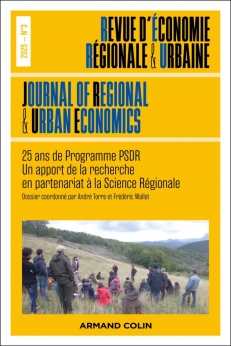
REVUE D'ÉCONOMIE RÉGIONALE ET URBAINE (3/2025)
Pour acheter ce numéro, contactez-nous
Recevez les numéros de l'année en cours et accédez à l'intégralité des articles en ligne.
La complexification des procédés et procédures de développement territorial a induit aux yeux des acteurs locaux une perception d’opacité et de complication, réelle ou ressentie, des institutions, des organisations, et des procédés qui leur sont liés. Notre hypothèse est que l’intelligence collective est un facteur de réussite de démarches territoriales réellement co-construites et contribue à rechercher une adéquation entre organisations et dynamiques collectives. Dans le projet de recherche-action Sagacité, au-delà d’un cadrage conceptuel, ont été évaluées les conditions concrètes de sa mise en œuvre. Interaction, cognition et action apparaissent comme étant au cœur de sa construction et sont utilisées pour évaluer les enseignements de sa mise à l’épreuve dans les collectifs du projet. C’est ainsi à notre sens que l’intelligence collective est plus que la somme des intelligences individuelles et contribue à la montée en capacité du groupe pour influer sur les dynamiques de changement et les trajectoires territoriales. Il en ressort que l’intelligence collective peut être définie, caractérisée, et mise en œuvre. En fin de projet des outils et méthodes ont été formalisés pour transposer ce type de démarche.
The increasing complexity of territorial development processes and procedures has induced local actors to perceive the opacity and complication, real or perceived, of the institutions, organizations and processes linked to them. Our hypothesis is that a better knowledge of collective intelligence and especially of the conditions of its implementation is a factor of success of truly co-constructed territorial approaches and can contribute to finding a match between organizations and collective dynamics. In the Sagacité action-research project, beyond a conceptual framework, the concrete conditions for its implementation have been assessed. Based on this framework and the lessons of the project groups, the objective here is to seek to highlight the keys to understanding and the most significant benchmarks that make it possible to recognize a collective intelligence approach. Interaction, cognition and action appear to be at the heart of its construction and are used to assess the lessons of its testing in the project groups. Above all, the processes of cognitive production are both results and constituents of collective intelligence: the writing of a shared problem, the co-construction of a collective understanding of the context which results in an evaluation of the room for maneuver to seek to influence this context emerge as significant processes. It is thus in our opinion that collective intelligence is more than the sum of individual intelligences and contributes to the rise in capacity of the group to influence the dynamics of change and territorial trajectories. It emerges that collective intelligence can be defined, characterized, and implemented. At the end of the project, tools and methods were formalized to transpose this type of approach.